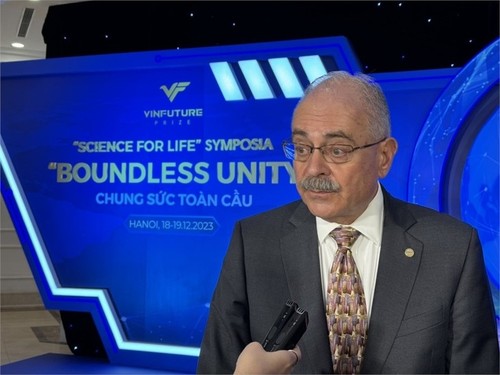 Professor Albert Pisano, Dean of Jacobs School of Engineering at the University of California San Diego (Photo; VOV) Professor Albert Pisano, Dean of Jacobs School of Engineering at the University of California San Diego (Photo; VOV) |
Reporter: What do you think of Vietnam’s capacity to become involved in the semiconductor industry?
Professor Pisano: The first thing we learned from the discussion this morning is that there will be a lot of work to do in the semiconductor industry to make it sustainable for the future. The other thing we learned is that there are ways for all countries, big and small, to enter the semiconductor market. And one of the discussions was the best way to enter the market. This is perhaps not to try to make the biggest, most complicated chip first, but to start with smaller projects that allow a country such as Vietnam to develop the logistical supply chains to support the industry and become strong. And there was an example drawn from looking at the history of China, which started at a component level and after a sustained period of time became very, very powerful in this industry. Many people in this meeting feel Vietnam can do the same.
Reporter: Can you tell more in detail? At the current starting point, which segments of the industry from chip design to exploratory data analysis (EDA) or manufacturing can Vietnam enter?
Professor Pisano: I think we will find that many countries are waiting and hoping Vietnam enters the field. Vietnam has already shown that it can quickly construct manufacturing industries in order to supply consumer goods. So if we look at microelectronics and semiconductors, perhaps a large 2 nanometer silicon fab may not be the right place to start. But following the example of the dominance that Vietnam has in manufacturing earbuds, this is an example of many industries coming together – plastics, acoustics, microelectronics, batteries, and wireless. This I think is an example that demonstrates Vietnam can enter this field. So I’m thinking that if there are more products like that, this is the perfect entry point because Vietnam has already done it and everyone is happy that it did.
Reporter: In your opinion, what should Vietnam do to develop its semiconductor companies? Which models of the world do you think Vietnam should follow?
Professor Pisano: So today at this Symposium we heard from Singapore and from other countries that have been successful in building semiconductor industries. And the first advice that they gave was make friends, form partnerships, and find others who want to share economic value with you so that together you can build the industry instead of building it on your own. And I think there were several examples given of that successful approach. I’m sure that with the success Vietnam has already had, you can follow this pattern and be even more successful than before.
Reporter: What should Vietnam pay attention to in training human resources for the sector?
Professor Pisano: I would offer that Vietnam is already taking the first steps to prepare the workforce for semiconductors. You have a number of universities that are getting better and better every day. As you know, VinUni is among them, but there are many others as well. Today I spoke to several of the faculties from those universities and reviewed their projects. And I have to say, the quality and the imagination of the projects and their semiconductors is wonderful. And it’s right at the cutting edge. So you have begun the training process. You have the research and the education systems in place. Now I think you must continue and train more graduates, push people through the system and then solutions will start coming to you.
Reporter: Thank you for your time talking with VOV. That was Professor Albert P. Pisano, the dean of the Jacobs School of Engineering of University of California San Diego.
Professor Pisano: Thank you!
Professor Albert Pisano is a co-inventor listed on more than 20 patents in MEMS (Micro-Electromechanical System) technology and has co-authored 300 publications.
In 2001, Pisano was elected to the National Academy of Engineering for contributions to the design, fabrication, commercialization, and educational aspects of MEMS.
In 2008, he was named one of the 100 Notable People in the Medical Device Industry by Medical Devices and Diagnostic Industry (MD&DI) Magazine.